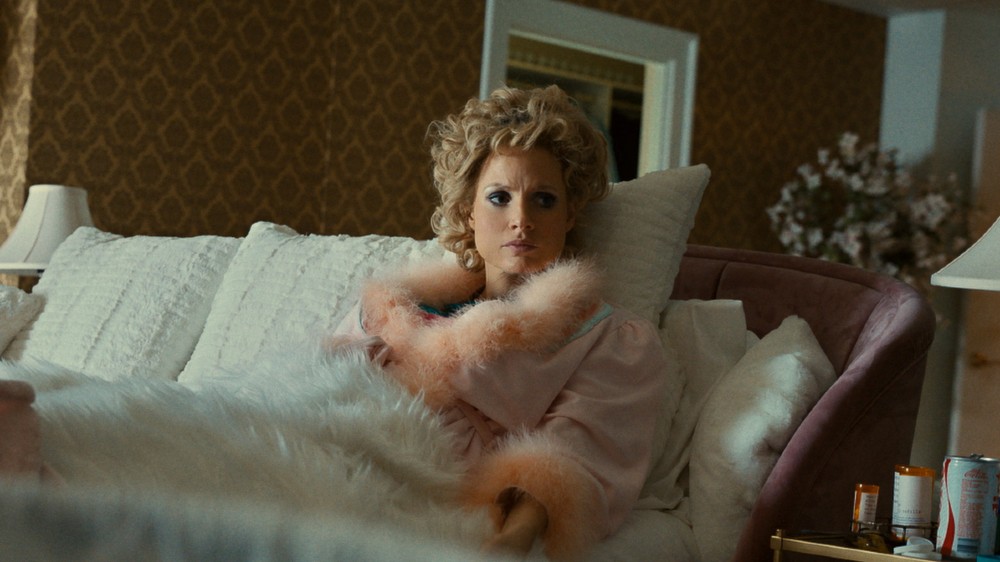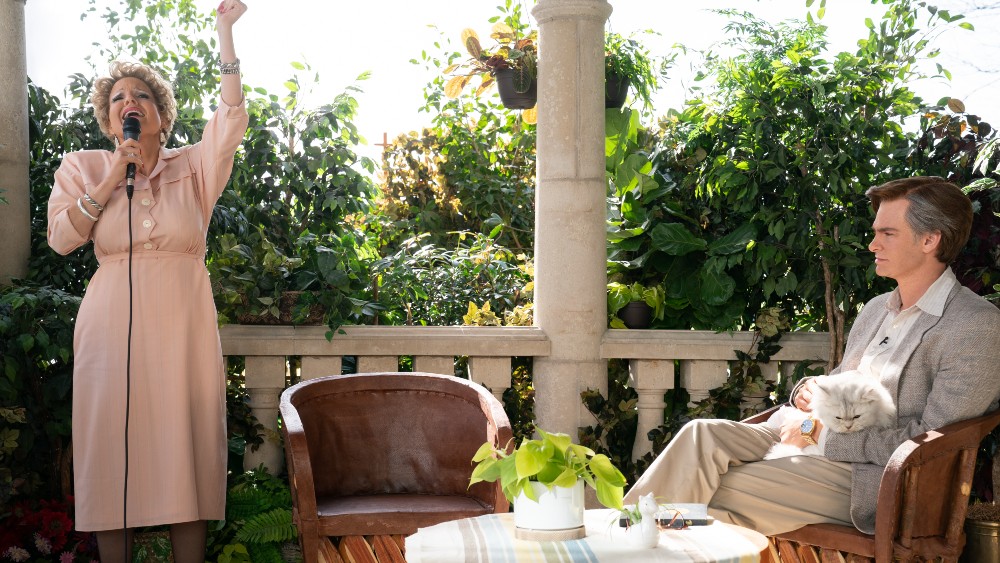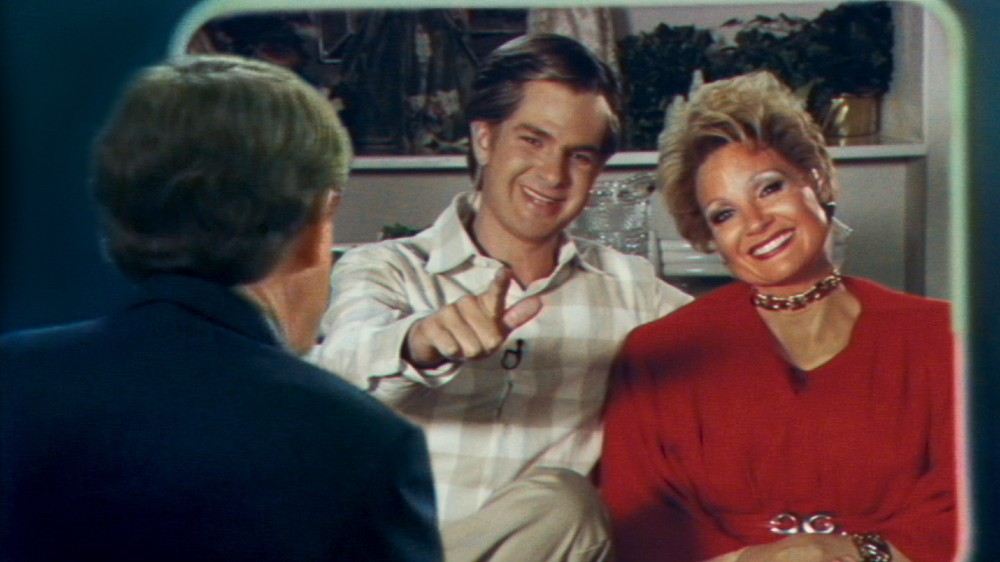
Televangelists Jim and Tammy Faye Bakker were best known and remembered for a lot of things, particularly for the scandal they faced when it was discovered their PTL Club had been scamming constituents out of their money. Although that aspect of the Bakkers might stick in many people’s memory, others will remember Tammy Faye for her amazing fashion sense (and frequent overuse of makeup) both on their popular television show and while appearing in public.
In The Eyes of Tammy Faye, directed by Michael Showalter (The Big Sick), Jim and Tammy are played by Andrew Garfield and Jessica Chastain, and part of making the actors look like their real-life counterparts fell to Costume Designer Mitchell Travers, who was tasked with fitting Chastain into outfits that spanned the decades and Tammy Faye’s changing fashion styles to match the times. Travers did a deep dive to research all of Tammy Faye’s outfits from over the years to make it easier for Chastain to transform herself into the role.
Travers also created the amazing costumes for Jon M. Chu’s New York-based musical, In the Heights, and he received a Costume Designers Guild Award nomination (and others) for his costumes for 2019’s Hustlers.

Below the Line spoke with Travers specifically about The Eyes of Tammy Faye a few weeks back.
Below the Line: I see you’ve been working in costume since 2009, so what started you down that road? Did you go to school for fashion design or specifically for costumes?
Mitchell Travers: I wanted to be a costume designer since I was a child. I went to school for costume design, and I got my degree, and then I started working in the industry. As you say, I did everything from PA to costume coordinator, shopper, assistant, associate designer. That’s what they say: if you work hard enough, you work your way up the ladder. I’ve been holding on and it paid off, and now I get to do my own work. It’s been a really wonderful climb.
BTL: Was there a specific movie you saw when you were younger that got you wanting to work in costumes?
Travers: I remember being young and seeing the behind-the-scenes clips of Jean Paul Gaultier, who did the costumes for The Fifth Element. I remember it was the first time that I had really connected the dots that it was somebody’s job to make the costumes for the movies, because I was fascinated by movies as a child. I loved that I could escape into these worlds and other places I had never seen before, but I truly had never connected to the idea that it’s somebody’s job to do that. So watching this behind-the-scenes feature on that movie, I’ll just never forget it. It was one of those moments where my brain just sort of clicked into it tonight. I knew, and I was like, “This makes perfect sense for me.”
BTL: I tend to forget that many of the people I talk to are younger than me, so I wasn’t expecting something as recent as The Fifth Element.
Travers: I forget what year that was, but I knew quite young. Most people around me had no idea what they wanted to be when they grew up, but I was pretty dead-set on this.
BTL: I know that Eyes of Tammy Faye was your first time working with Michael Showalter, so what was your first meeting with him like? Obviously, there’s a lot of pictures and video of the Bakkers from back in the day, so were there people you could talk to who worked on the outfits for their television show? Or did you have to figure it all out yourself?
Travers: When I first met with Michael, he had such a fantastic sense of humor about things, but he’s also really emotionally invested in his characters, too. It was really wonderful that he was able to enjoy the humor of the scripts, but also really flesh out the humanity of these people and understand them from all angles and really appreciate some of the struggles that they went through, and understand some of the terrible things that happened around them. He was really able to come at it and empathize with them and paint a broader picture than I think a lot of the media depiction cast up until that point.

One of the things I did on this movie was I assembled an enormous collection of every image I could possibly find of the Bakkers, both Jim and Tammy, and then I started to compile them down into a five-year span. What I wanted to do mostly was just understand how they evolved and changed with money, with fame, as their relationship ebbed and flowed, with children, with influence, with power, with scandal. I just wanted to understand all of those different phases and how it affected the way that they presented themselves to the world. One of my first meetings with Michael was going through and just talking through the evolution of the two people from what I could gather, just on real images of the people. And then, we started to talk about what we could do from a costume perspective. How could we use what we were able to learn just being detectives with images? How can we use what we learned about those people and their closets for our movie, and how could we help tell the story through the clothing. He was a great collaborator to me. He gave me wonderful creative freedom in that there were certain key moments that he wanted to match frame for frame almost, and then there were others that he gave me total flexibility and freedom on to color outside the lines a bit, just using this great library of research that we were able to come up with.
Travers: I went really deep. I would be surprised if someone could show me an image of either of them that I have not seen and studied. I did get some family photographs, Our movie starts with them in college, so I was able to get some photographs that really hadn’t been seen very much. I was able to talk to people that have known them throughout their lives and seen family photos and vacation photos and things that aren’t really published. I felt like I was really able to put them under a microscope and just be compassionate in my research and understand them as complicated people to the best of my ability, or to the best of what photographs show. There really was a wonderful back and forth between public photographs and private photographs, because I think that told me so much about how people present themselves when they know the cameras are there, and how people present themselves when they’re just candid.
BTL: Were these outfits that you could find or put together from found objects, or did you have to design and create all of them from scratch just by looking at the pictures and videos?
Travers: It’s a real combination. I built a lot of the clothes for Tammy just because she had a really specific sense of style. I mean, no one can do Tammy like Tammy, so I really felt like she gave me an incredible arsenal to work from in that she made such specific choices that I feel like no costume designer could even get close to her styling. Sometimes, it was best to just let her drive and follow her lead and get as close to some of her most iconic looks as we could. For some of the courthouse appearances, we tried to match as closely to what Tammy actually did, because I really do feel like she made some great costume design choices in her life. Some of those things we matched frame for frame and then others, I was able to build up an understanding of what was in her closet around that time. I would shop vintage, and I would flesh out closets for early 80s, late 80s, early 90s, late 90s. I would shop it with the same mindset that I started to understand, because I had studied her closet so closely.
It’s a specific story, but I hope it serves the point. I remember in my research tracking a very specific silver pair of earrings that she buys in the early 70s. She wears a ton in the early 70s, and then they sort of disappear, and then they come back in the 90s. And so, I understood her closet so intimately that I remembered them, because they felt like my closet. I thought it was really interesting that they came in at a point in which she was just sort of gaining notoriety and fame, and so they weren’t anything really special or magical, or designer or anything crazy. I thought it was really interesting that they came back into her imagery at that point, as her sort of star had faded a bit, and she was known more for scandal than some of the preaching that she had done. I just thought it was interesting that some of those pieces that she had in her youth had started to come back out after all of this big scandal and big designer clothes and things. There’s a lot of storytelling that you can learn from someone by studying them intimately. Things like that I found really helpful in my designs for Tammy.
BTL: How do you put together a team for a movie like this? Do you have people who you try to work with on every show, or do you have to base your team where the production is filming?
Travers: I love the shorthand that comes from working with people that you’ve worked with before. I have a select group of people that I always reach out to and try to work with, but at the same time, I think assembling the crew is really about chemistry and playing to strengths. We were a smaller team than I think people would realize just based on the scope of the movie. I had two assistant designers with me and a background costume designer and background supervisor. We had about four costumers with us most days. Obviously, we swelled on some of our bigger days — costume coordinator– and then we have two full-time tailors. So we weren’t a very big team in terms of a costume team, but we were able to pull off some enormous units. We had massive audience days to fill out the PTL Studio. We had the Orville Roberts University in the 90s. I’m very specific about the way I use background in film, and I think it really helps to paint a picture and help tell your story and continue your narrative.
The tough part for us wasn’t just some big group of background that we could reuse all the time, because when we first started seeing the audience members of the PTL, I wanted it to feel wholesome and friendly and inviting, like your favorite aunt and uncle in the audience or your grandparents. But then our stories start to become muddied and unclear. I wanted the same thing to happen with the audience, so we started to use sharper colors. It was almost like two different color palettes that we wanted to use. So every time that we had large groups of background, it was like starting from scratch with them, because they had to serve such a specific purpose in our movie. It really was an enormous undertaking.
BTL: Where and when did you film this?
Travers: We shot in North Carolina.
BTL: This was before COVID?
Travers: Yes, this was before COVID. We were in Charlotte, and some Charlotte locals were on our team. We brought in a few people from New York to LA, but yeah, we shot all in Charlotte, lovely place to shoot, honestly.
BTL: What’s it like collaborating with Jessica and Andrew because the outfits are so specific, but also you want to make sure they’re comfortable. Do you have to modify things to make sure look good but also feel right?
Travers: Jess and I really collaborate very closely. This is a very specific woman, and I think there was always the risk of taking things too far or for things to become parody. Because of course, I believe that’s what the media did to Tammy Faye is they took her into a sort of cartoonish place. We were always very careful to be honest about depicting a real woman, all sides of her. And so, Jess and I worked very closely to make sure that we had a good balance. We had to understand, of course, the prosthetics that were on and I had multiple bodysuits that were made for her to change her body over the course of time. We were able to track down how her body changed with various weight gain, with surgeries, with becoming a mother. We wanted all of that to carry through, and be honest about the changes that the real Tammy has gone through. It was almost like fitting a few different women. Normally your actress, you understand her body, you can do her clothes for the movie, but working with Jessica in this way, it was almost like working with five or six different people, because we had to dress them so differently, and she was such a different size at each phase of her life, so we had to be really careful. We had to do it together to achieve something that was honest and real. And at times, very presentational, and at times, very private as well. So it really was very carefully done together.
BTL: I didn’t recognize Vincent D’Onofrio as Jerry Falwell, but he also has a very distinct style. Can you talk about that?
Travers: For Vincent, one of the things I loved most about actually looking at the real man is that a lot of these men, for all of their money, they really had poorly-tailored suits. And so, it was something I didn’t want to shy away from, and I wanted to lean into that. For all of their presentation and all of their money and all their wealth, they kind of forgot the details, and they forgot the little things that make it important. It was sort of counterintuitive, but we worked hard to get it a little sloppy, and then I really wanted to just drain the color from Vincent. He’s got such strength, and of course, the character has, for me, such an evil presence, so I really just wanted to drain out the color and really make it almost inhumane.
The Eyes of Tammy Faye will open in select theaters on Friday, Sept. 17.
All photos courtesy Searchlight Studios, except where noted; click on images for larger versions.






